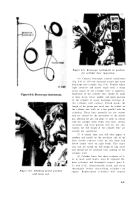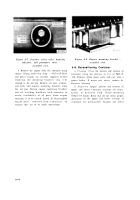TM-9-2815-200-35
ENGINE, WITH CONTAINER:TURBOSUPERCHARGED, DIESEL ,FUEL INJECTION ,90-DEGREE “V” TYPE, AIR - COOLED ,12 - CYLINDER , ASSEMBLY ;MODELS AVDS-1790-2M (2815-856-4996), AVDS-1790-2A AND AVDS-1790-2AM (2815-856-9005)
TECHNICAL MANUAL; DIRECT SUPPORT, GENERAL SUPPORT AND DEPOT MAINTENANCE MANUAL INCLUDING REPAIR PARTS AND SPECIAL TOOLS LISTS
TM-9-2815-200-35 - Page 559 of 779
turned to the “ON” position, and the engine
started and operated not over 1200 revolutions
per minute (RPM) until observed fuel return is
purged of diesel fuel and the system filled with
preservative oil.
b.
All openings such as exhaust manifolds, air
intakes, breathers, etc. shall not be sealed.
Note.
The engine requires no special de -
preservation procedures to be made serviceable.
8-12. Engine Installation
a.
The turbosupercharger outer shroud plate
assembly and the intermediate shroud plate on
both the right and left bank must be removed, in
order to provide proper clearance for the engine
in the container. On engines which have the oil
filler tube installation at the rear of the engine,
the upper portion of the two piece tube must be
disconnected and removed. Refer to figure 4-18
through 4-21 and 4-23 for removal of the shroud
plates and upper portion of the oil filler tube.
The parts that have been removed from th e
engine, must be packaged separately to prevent
damage and secured to the engine or container
prior to assembling container halves.
b.
Inspect engine thoroughly for loose or
missing parts or components. Check to be sure
engine has been properly identified as having
been preserved for storage. Install the two engine
mounting brackets on the three centrally located
oil pan mounting bosses on either side of the
engine (fig. 8-8). Install the six bolts from the
underside of the oil pan and assemble a washer
and a nut on each bolt. Tighten securely. The
engine mounting brackets must be installed on
the engine prior to installing engine in container.
c.
Loosen but do not remove the six nut s
securing transmission adapter support flange to
the container cross member (fig. 8-10). Using
engine lifting multi-leg sling - 4910-919-2884,
carefully guide the engine into position on the
engine mounting bracket hold-down studs in the
container. Aline the rear transmission adapter
support flange screw holes with the screw holes
in the engine transmission adapter and install six
1¾ in. screws and lock washers starting with the
upper right and left screw holes on the support
flange. Install one 1½ in. screw and lock washer
in the remaining screw hole in the lower center of
the support flange. Tighten all screws securely.
Install the four nuts and lock washers on the
engine mounting bracket hold-down studs and
securely tighten engine-to-container engin e
mounting flange. Tighten the six nuts that secure
the transmission adapter support flange .
Position parts that have been removed from the
engine and tape or strap separately to engine
and support cross members.
Note.
Engines that are being returned for
rebuild should be securely mounted in container.
The loose parts that have been removed from the
engine should also be secured by some means to
prevent shifting and causing additional damage
to the engine and container during transit.
Figure 8-10. Transmission adapter -
installed view.
d.
Fill each of the two desiccant baskets (fig. 8-
9) mounted on the side wall of the container,
with
eight
bags
of
desiccant
(MIL-D-3464,
16
unit bags, Class 1). Apply sealing compound
conforming
to
MIL-I-8660
on
the
sealing
gasket and position the sealing gasket on the
container flange. Assemble the upper section of
the container to the lower section .
Torqu e
tighten assembly bolts to 90-105 lbs ft.
e.
When assembly is complete, pressurize the
container 5 to 7 psi of dehydrated air and allow
container to stand for a minimum of twelve
hours to be sure air pressure is maintained.
f.
Periodic inspection of containers that are to
be stored for extended periods of time should be
made to determine if the pressure of moisture is
evident in the container. This is determined by
the humidity indicator located in the recessed
insert on the end of the container (fig. 8-7).
Under moisture-free conditions, the indicator
will show blue in color. As the presence of
8-17
Back to Top




















